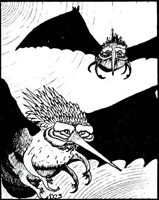
Incidentally, Gygax originally intended the word to be pronounced as "boo-lay", and official material from WoTC, and TSR before them, used to insist on this - and maybe still does. This raises a question, often seen in fantasy literature more generally, of "then why didn't you spell it that way?" In this case, I'll note that both the spelling and the supposed pronunciation appear vaguely French, which may be intentional - although, obviously, they don't match up with one another in that language either...





